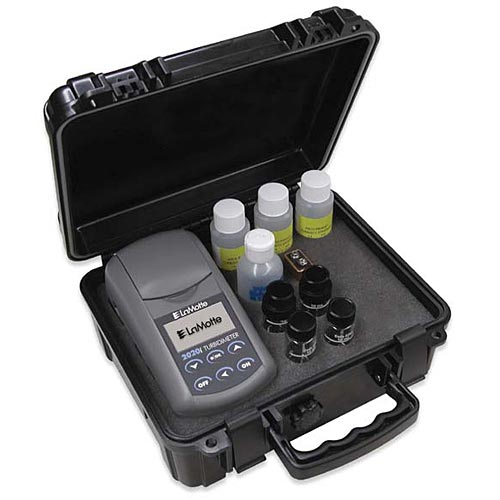Turbidimeter surface water
This measuring device is used to define the clarity/turbidence of the surfacte water.
Summary description of technology
This technique measures the extent of scattering or absorption of light using infrared light in surface water. This is a measure of the suspended solids content expressed in NTU or FNU. There are two types of meters. One can be used to measure directly in surface water. With the other species, this takes place in a sample bottle.
Specific information
| General information | |||
| Name | Turbidimeter surface water. | ||
| Unit of measure and parameter | Scattering or absorption of light in FNU or NTU. or, suspended solids concentration in g/l or ppm | ||
| Nature technique | Physical | ||
| Place of application | in situ | ||
| Detection Mode | Measurement on surface open water | ||
| Applicable in separate layers | Minimum layer thickness: N/A | ||
| Land soil/water bottom | water bottom | ||
| Step in the data collection chain | Measure | ||
| Moment of availability results | Measurement results are available in the field | ||
| Technology development phase | Applied routinely | ||
| Method of purchasing | as service or as a device | ||
| General description of the implementation method | The device is suspended in the water column and emits infrared light at a certain angle. By reflecting the light on floating components, an amount of radiation is reflected and measured again by the device (within a radius of a few centimeters). The device is used in combination with a measuring amplifier. There are two versions of turbidimeters: a sensor connected to a multimeter or a compact PC field kit. In the first case, after calibration, the sensor can be hung directly in surface or ground water. In the second case, a sample vial is filled and analyzed in the PC field kit. | ||
| Working principle | The radiation from an infrared emitter hits the medium at a certain defined angle. The particles in the medium generate a scattering of the radiation, which in turn is received by a receiver. The settings are media dependent. The difference between outgoing and re-collected radiation is compared and expressed in a unit of radiation (FNU or NTU) or (after local calibration) in g/l suspended matter. | ||
| Point / line measurement / volume measurement | Point measurement | ||
Technical specifications (including accuracy) | The measuring range is: 0.01 - 1000 FNU to 100 g/l. The measuring range and accuracy depends on the type of sensor and conditions. | ||
| Typical depth range | Maximum 50 meters in case of in-situ measurement. Sensitivity independent of depth | ||
| Time properties | The measurements can easily be repeated regularly. | ||
| Measuring rate | A measurement takes approximately 10 minutes. The measured value can be read directly on the display of the device. | ||
| Presentation results | The values read (whether or not after calibration) | ||
| Cost | Purchase equipment (sensor and transmitter) from € 2,500 (depending on version and type). | ||
User information | |||
| Availabilty | large number of providers | ||
| Is technology often used? | Very organized | ||
| Research phase in which technology can be applied |
| ||
| Verification measurements / calibration measurements | are often used | ||
| Frequently used application in practice | During dredging work it is important that turbidity does not exceed certain predefined values. This can be easily determined with the turbidimeter. | ||
| Suitability | The turbidimeter is extremely suitable for measuring the transparency in surface water. If use is made of the embodiment with which measurements are taken in a sample bottle, the transparency of groundwater or waste water can also be measured, for example. | ||
| Practical experiences in the Netherlands | Extensive experience in practice in the Netherlands has shown that the results are good and the measurements can be carried out smoothly and the measurement data is quickly available. | ||
| “Dos“ | The turbidimeter can be used for long measuring distances because a wiper keeps the optical parts clean (fog is prevented/removed). The 4-beam measuring principle checks the sensor itself. | ||
| “Don'ts“ | Air bubbles can affect the result. Therefore, for example, do not apply near dredging activities. | ||
| Also suitable for | Water temperature measurements. | ||

